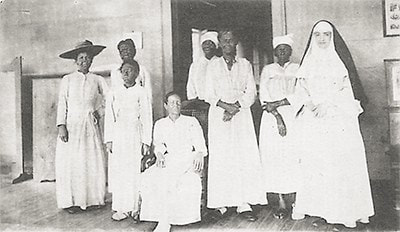|
A Dominican Sister with female lepers at Chacachacare in the early 1930s. On December 29, 1921, acting Governor of T&T, T A V Best, proclaimed Chapter 8 of Ordinance 42 before the Legislative Council in the Red House. The idyllic holiday homes and simple farmer-fisherman lifestyle of the island of Chacachacare was changed forever, for this piece of legislation immediately appropriated all land thereupon (except that belonging to the Roman Catholic church) to be property of the Government and orders were issued for all inhabitants to clear out forthwith.
This draconian move was intended to clear the space for what would become known as the “Molokai of the Caribbean,” that is to say, a leper colony. In the months following the declaration, the Public Works Department began a massive construction drive which saw an entire village being established at Sander’s Bay, complete with a bakery, mess hall and administrative offices as well as an infirmary. Male and female inmates were to be lodged separately, the latter in small cottages. There were chapels as well for the Roman Catholic and Anglican faiths with a small Hindu mandir being added later. A Delco plant provided electricity to some of the buildings, while the patients’ quarters had to make do with kerosene lamps. As the facilities neared completion, the transfer of patients from the Cocorite Leprosarium (in service since 1845) began under the supervision of the police to ensure that none would attempt to escape the enforced exile that awaited them on the desert island where as ever, water was so scarce, it had to be carefully hoarded in large concrete cisterns. One interesting situation that arose from the movement of the first patients is that those who were only mildly affected by the disease were transported first. They worked alongside the Public Works labourers in the building process and received a small wage for their services. As detailed in one of my earlier articles on the Cocorite Leprosarium, the lepers had been cared for since 1868 by Dominican nuns from France. Their selfless devotion did not now wane in the face of the transfer and they intended to follow their charges thither. A convent and chapel dedicated to Our Lady of the Rosary were built at Marine Bay and perched on a steep incline. To get to the settlement at Sander’s Bay would entitle a strenuous row in an open boat and every evening upon completion of their duties, the sisters would face a brisk climb to their quarters. The relocation of these valiant Sisters began in September 1926 and not without some sadness, since the Reverend Mother Thomas Nigay, who had loyally served at Cocorite since 1890, died before the move after a long illness. There was further grief upon arrival at Chacachacare since Prioress Mother Marie was dying and would breathe her last on the island three months later. Her remains were the first laid to rest in the little cemetery of the nuns on the island where in the coming years, others would join her, having given their lives in the service of the sick. A motor launch servicing the leper colony was named in Mother Marie’s honour. The official inauguration of the new “Hansenian Settlement” was performed on November 18, 1926, the last patients and their caregivers having arrived barely a month before. This final batch of lepers were those who had been so ravaged that they could not walk and had to be carried about on stretchers. It is quite difficult now to appreciate fully the feelings of those who moved to Chacachacare. For the patients, it would mean that there would nevermore be contact with family and friends except by the occasional letter. Whatever emotions the Dominican Sisters felt must have been quickly suppressed, for they plunged into their duties with no delay. In time, it became obvious that in order to ensure the proper care of the most incapacitated patients, a night shift would have to be initiated at the infirmary in Sander’s Bay. Once again, the brave nuns were ready to assist and a small hostel was prepared for those who chose to work overnight rather than return to the convent. Dr Ferdinand De Verteuil, a hard-working physician from an old Trinidadian family, acted as medical superintendent on the island until the arrival of Dr Welch, an Englishman, on October 10, 1926. It is interesting to note that the superintendent was housed in one of the old holiday homes at Rust’s Bay along with his family that included several small children. Credit : Angelo Bissessarsingh (2016)
0 Comments
Leave a Reply. |
T&T news blogThe intent of this blog is to bring some news from home and other fun items. If you enjoy what you read, please leave us a comment.. Archives
April 2025
Categories
All
|


 RSS Feed
RSS Feed